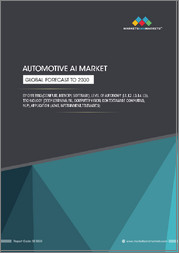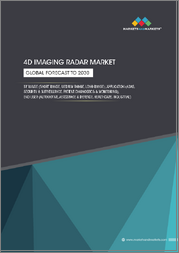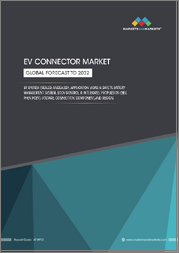
|
시장보고서
상품코드
1479923
첨단운전자보조시스템(ADAS) 시장 - 예측(2024-2029년)Advanced Driver-Assistance System (ADAS) Market - Forecasts from 2024 to 2029 |
||||||
첨단운전자보조시스템(ADAS) 시장은 예측기간 동안 17.57%의 복합 연간 성장률로 성장할 전망이며, 2022년 277억 4,100만 달러로 평가되었고, 2029년에는 861억 4,000만 달러 규모에 도달할 것으로 예측됩니다.
첨단운전자보조시스템(ADAS) 시장은 운전자의 운전 기능을 지원하는 전동 기술입니다. ADAS는 센서, 카메라 및 레이더를 사용하여 신호, 보행자 및 기타 모든 장애물을 자동차의 사각에서도 감지합니다. 이를 통해 사고를 미연에 방지하고 인명을 구할 수 있습니다.
이 ADAS는 차량과 교통의 안전성을 높입니다. 첨단운전자보조시스템(ADAS) 시장에 공헌하고 있는 주요 요인은 사고 건수 증가와 정부에 의한 규제의 의무화입니다.
또한 OEM 시장 확대와 자동차 자동화에 관한 연구개발 증가는 모두 시장에 크게 기여하고 있습니다. 이 시장은 전기차와 자동차 수요가 증가함에 따라 확대될 것으로 예상됩니다. 엄격한 규제로 인해 북미와 유럽은 시장에서 큰 점유율을 차지합니다. 그러나 인구가 증가하고 가처분 소득이 증가함에 따라 ADAS 수요는 APAC 지역에서 확대되고 있습니다.
시장 성장 촉진요인
- 사고 방지 수요
세계 교통사고 건수 증가에 따라 운전자의 안전 대책으로 ADAS를 의무화하고 있는 국가도 있습니다. 세계보건기구(WHO)에 따르면 교통사고로 인해 매년 약 130만 명이 사망하고 있습니다. 게다가 약 2,000만 명에서 5,000만 명 이상의 사람들이 치명적이지 않은 부상을 입었습니다. 이러한 사고의 약 90%는 중저소득국에서 일어나고 있습니다.
교통사고의 주요 요인은 속도 위반, 헬멧, 시트 브리츠, 어린이용 시트의 사용, 사각, 안전하지 않은 자동차 등의 인위적 실수입니다. 또한 안전하지 않은 도로 인프라와 부적절한 법규도 사고의 구조적 원인의 일부입니다. 그러나 ADAS를 사용하면 사각 감지, 자동 비상 브레이크, 보행자 감지, 차선 편차 경고 등의 시스템을 통해 대부분의 사고를 방지할 수 있습니다.
- 전기차 사용 증가
환경과 기후 변화에 대한 관심이 높아짐에 따라 전기차와 친환경 자동차에 대한 수요가 크게 증가하고 있습니다. 이러한 수요 증가는 ADAS(첨단 운전 지원 시스템) 시장에 긍정적인 영향을 미칠 것으로 예상됩니다. 많은 국가, 특히 유럽과 북미에서는 화석 연료 자동차의 사용 금지를 계획적으로 실시했습니다. 예를 들어, 영국은 2050년까지 인터넷 제로 방출을 달성하겠다는 목표를 세우고 있습니다.
또한 유럽연합(EU)은 2035년부터 가솔린차와 디젤차의 신차를 금지하고 있습니다. 노르웨이에서는 전기자동차가 월간 판매량의 60%를 차지합니다. 이 나라는 2025년을 목표로 화석연료를 사용하는 자동차 판매를 중단합니다. 미국에서는 캘리포니아 주가 2035년부터 가솔린 승용차 및 트럭의 신차 판매를 금지할 것을 제안하고 있습니다. 게다가 세계에서 가장 인구가 많은 중국에서는 전기차에 대한 수요가 높아지고 있습니다.
시장 성장 억제요인 :
- 비용과 기술의 복잡성이 저해 요인
ADAS 시스템의 통합은 차량 비용을 대폭 상승시켜 가격에 민감한 소비자가 차량을 이용하기 어렵게 만듭니다. 이 지출은 LiDAR 기술에 의존하는 고급 시스템에서 특히 두드러집니다.
다양한 센서, 소프트웨어 및 알고리즘의 융합에는 원활한 통합을 달성하기 위해 고급 엔지니어링 기술이 필요합니다. 이러한 복잡성은 종종 개발 기간의 장기화와 개발 비용의 상승을 초래합니다.
기술별 ADAS(첨단 운전 지원 시스템) 시장은 레이더, LiDAR, 카메라, 초음파 기술로 구분됩니다.
ADAS(첨단 운전 지원 시스템) 시장의 기술별 부문에는 레이더 기술, LiDAR 기술, 카메라 기술, 초음파 기술이 포함됩니다. 레이더 기술에는 어댑티브 크루즈 컨트롤, 사각 검출, 충돌 회피 시스템 등의 기능이 포함됩니다.
LiDAR 기술은 자율 주행 시스템, 차선 이탈 경고, 주차 지원 시스템 등의 기능을 제공합니다. 카메라 기술은 차선 편차 경고, 교통 표지 인식, 보행자 감지, 자동 비상 브레이크 등의 기능을 제공합니다.
초음파 기술은 주차 지원 시스템, 사각 감지, 물체 근접 센서를 포함합니다.
북미가 큰 점유율을 차지하는 전망 첨단운전자보조시스템(ADAS)
북미가 첨단운전자보조시스템(ADAS) 시장의 상당 부분을 차지할 것으로 예상됩니다. 북미 소비자들은 일반적으로 신기술, 특히 안전성과 편리성에 관한 신기술을 조기에 받아들인다.
북미는 다른 지역에 비해 다양한 ADAS 기능에 대응할 수 있는 뛰어난 연결성을 갖춘 비교적 첨단 인프라를 자랑합니다.
시장 개척 :
- 2023년 3월-영국 Launch Tech사는 최신의 승용차용 선진 운전 지원 시스템(ADAS) 적합 장치 「ADAS PRO 」와 「ADAS Mobile」을 발표. 차량 연결의 혁신으로 안전성 향상과 운전자 지원 기능이 자동차 사용자에게 제공되었습니다. 이 기술이 지속적으로 발전함에 따라 차량에 표준으로 장착되어 왔으며 교정 장비 수요가 꾸준히 증가하고 있습니다.
- 2023년 3월-BYD는 NVIDIA와 파트너십을 맺어 NVIDIA DRIVE를 기반으로 한 주류 소프트웨어 정의 차량을 개발. 이 제휴는 BYD에 의한 NVIDIA DRIVE Orin(TM) 집중 컴퓨팅 플랫폼의 활용을 보다 폭넓은 NEV로 확대하는 것을 목적으로 하고 있습니다. 이러한 강화된 파트너십을 통해 BYD는 차세대 차량인 다이나스티와 오션 시리즈의 여러 모델에서 DRIVE Orin의 채택을 확대하고 있습니다.
목차
제1장 서론
- 시장 개요
- 시장의 정의
- 조사 범위
- 시장 세분화
- 통화
- 전제조건
- 기준년 및 예측년의 타임라인
- 이해 관계자의 주요 이점
제2장 조사 방법
- 조사 디자인
- 조사 과정
제3장 주요 요약
- 주요 조사 결과
- 애널리스트 보기
제4장 시장 역학
- 시장 성장 촉진요인
- 시장 성장 억제요인
- Porter's Five Forces 분석
- 업계 밸류체인 분석
- 애널리스트 보기
제5장 첨단운전자보조시스템(ADAS) 시장 : 유형별
- 서문
- 자동 긴급 브레이크
- 시장 동향 및 기회
- 성장 전망
- 지리적 이익성
- 주차 지원
- 시장 동향 및 기회
- 성장 전망
- 지리적 이익성
- 사각 감지
- 시장 동향 및 기회
- 성장 전망
- 지리적 이익성
- 교통 표지 인식
- 시장 동향 및 기회
- 성장 전망
- 지리적 이익성
- 충돌 경고
- 시장 동향 및 기회
- 성장 전망
- 지리적 이익성
- 차선 일탈 경보
- 시장 동향 및 기회
- 성장 전망
- 지리적 이익성
제6장 첨단운전자보조시스템(ADAS) 시장 : 기술별
- 서문
- 레이더
- 시장 동향 및 기회
- 성장 전망
- 지리적 이익성
- LiDAR
- 시장 동향 및 기회
- 성장 전망
- 지리적 이익성
- 카메라
- 시장 동향 및 기회
- 성장 전망
- 지리적 이익성
- 초음파 기술
- 시장 동향 및 기회
- 성장 전망
- 지리적 이익성
제7장 첨단운전자보조시스템(ADAS) 시장 : 차량 유형별
- 서문
- 승용차
- 시장 동향 및 기회
- 성장 전망
- 지리적 이익성
- 상용차
- 시장 동향 및 기회
- 성장 전망
- 지리적 이익성
제8장 첨단운전자보조시스템(ADAS) 시장 : 지역별
- 서문
- 북미
- 유형별
- 기술별
- 차량 유형별
- 국가별
- 남미
- 유형별
- 기술별
- 차량 유형별
- 국가별
- 유럽
- 유형별
- 기술별
- 차량 유형별
- 국가별
- 중동 및 아프리카
- 유형별
- 기술별
- 차량 유형별
- 국가별
- 아시아태평양
- 유형별
- 기술별
- 차량 유형별
- 국가별
제9장 경쟁 환경 및 분석
- 주요 기업 및 전략 분석
- 시장 점유율 분석
- 합병, 인수, 합의 및 협업
- 경쟁 대시보드
제10장 기업 프로파일
- Robert Bosch GmbH
- Continental AG
- Aptiv
- Valeo
- Autoliv Inc.
- DENSO corporation
- Magna International Inc
- HELLA GmbH & Co. KGaA
- Mobileye
- Delphi Automotive
The advanced driver-assistance system (ADAS) market is expected to grow at a compound annual growth rate of 17.57% over the forecast period to reach a market size of US$86.14 billion in 2029, from US$27.741 billion in 2022.
The advanced driver-assistance systems market is an electric technology that assists the driver with driving functions. ADAS uses sensors, cameras, and radars to detect signals, pedestrians, and any other obstacle, even in the blind spots of the vehicles. This allows us to prevent accidents and save human lives.
This ADAS increases vehicle and road safety. The key factors contributing to the advanced driver-assistance system market are the growing number of accidents and mandatory regulations by the government.
Furthermore, the growing OEM market and increased R&D on automotive automation are both significant contributors to the market. The market is expected to rise along with rising demand for electric and automotive vehicles. Due to strict regulations, North America and Europe hold a significant share of the market. However, with the growing population and rising disposable income, the demand for ADAS has grown in the APAC region.
Market Drivers:
- Demand for accident prevention-
With the number of global road accidents increasing, some countries have made it a mandatory measure for driver safety. According to the World Health Organization (WHO), approximately 1.3 million people die each year due to road traffic crashes. Furthermore, around 20-50 million more people suffer non-fatal injuries. Around 90% of these accidents happen in low-and middle-income countries.
The prime factors in road accidents are human errors like speeding, not using helmets, seat bleats, child restraints, blind spots, and unsafe vehicles. In addition, unsafe road infrastructure and inadequate laws and regulations are some of the structural reasons for accidents. However, the use of ADAS can prevent most accidents with, systems like blind-spot detection, automatic emergency braking, pedestrian detection, and lane departure warning, amongst others.
- Increasing use of electric vehicles-
With the rising concern for the environment and climate change, the demand for electric vehicles and eco-friendly vehicles has increased significantly. This increase in demand is expected to positively impact the advanced driver-assistance systems market. Many nations, especially in the region of Europe and North America, are systematically imposing a ban on the use of fossil-fueled cars. For instance, Britain has set a target to become net-zero emissions by the year 2050.
Furthermore, the European Union has imposed a ban on new petrol and diesel cars from the year 2035. In Norway, electric cars account for 60% of the monthly car sales. The country has set a target of 2025 to stop sales of fossil fuel-powered cars. In the United States of America, the state of California proposes to ban new gasoline-powered passenger cars and trucks from 2035. Moreover, the world's most populous country, China, has a rising demand for electric vehicles.
Market Restraint:
- Cost and technological complexity as restraints-
The integration of ADAS systems substantially increases the cost of vehicles, rendering them less accessible to price-sensitive consumers. This expense is particularly pronounced for advanced systems, such as those reliant on LiDAR technology.
The amalgamation of diverse sensors, software, and algorithms necessitates sophisticated engineering skills to achieve seamless integration. This intricacy often results in prolonged development periods and elevated development expenditures.
The Advanced Driver-Assistance System (ADAS) market by technology is segmented into Radar, LiDAR, Camera, and Ultrasonic technologies:
The segmentation of the Advanced Driver-Assistance System (ADAS) market by technology includes Radar, LiDAR, Camera, and Ultrasonic technologies. Radar technology encompasses features such as adaptive cruise control, blind spot detection, and collision avoidance systems.
LiDAR technology offers functionalities for Autonomous Driving Systems, lane departure warning, and parking assistance systems. Camera technology provides capabilities for lane departure warning, traffic sign recognition, pedestrian detection, and automatic emergency braking.
Ultrasonic technology involves park assist systems, blind spot detection, and object proximity sensors.
North America is anticipated to hold a significant share Advanced Driver-Assistance System (ADAS) market:
North America is expected to retain a substantial portion of the Advanced Driver-Assistance System (ADAS) market. North American consumers typically embrace new technologies early, especially those related to safety and convenience.
Compared to other areas, North America boasts a relatively advanced infrastructure with superior connectivity, capable of accommodating various ADAS functionalities.
Market Developments:
- March 2023- Launch Tech UK unveiled its latest passenger car advanced driver assistance systems (ADAS) calibration equipment, ADAS PRO+ and ADAS Mobile. Innovations in vehicle connectivity ushered in safety enhancements and driver assistance features for motorists. With ongoing advancements in this technology, which were increasingly becoming standard in vehicles, the demand for calibration equipment had been steadily increasing.
- March 2023- BYD forged a partnership with NVIDIA to develop mainstream software-defined vehicles based on NVIDIA DRIVE. The collaboration entailed extending BYD's utilization of the NVIDIA DRIVE Orin(TM) centralized compute platform to a wider range of its NEVs. This enhanced partnership saw BYD expanding its adoption of DRIVE Orin across multiple models within its next-generation Dynasty and Ocean series of vehicles.
Market Segmentation:
By Type
- Automatic emergency braking
- Parking Assistance
- Blind Spot Detection
- Traffic sign recognition
- Collision Warning
- Lane departure warning
By Technology
- Radar
- LiDAR
- camera
- Ultrasonic
By Vehicle Type
- Passenger Cars
- Commercial Vehicles
By Geography
- North America
- USA
- Canada
- Mexico
- South America
- Brazil
- Argentina
- Others
- Europe
- Germany
- France
- UK
- Spain
- Others
- Middle East and Africa
- Saudi Arabia
- Israel
- Others
- Asia Pacific
- China
- Japan
- India
- South Korea
- Others
TABLE OF CONTENTS
1. INTRODUCTION
- 1.1. Market Overview
- 1.2. Market Definition
- 1.3. Scope of the Study
- 1.4. Market Segmentation
- 1.5. Currency
- 1.6. Assumptions
- 1.7. Base, and Forecast Years Timeline
- 1.8. Key benefits to the stakeholder
2. RESEARCH METHODOLOGY
- 2.1. Research Design
- 2.2. Research Process
3. EXECUTIVE SUMMARY
- 3.1. Key Findings
- 3.2. Analyst View
4. MARKET DYNAMICS
- 4.1. Market Drivers
- 4.2. Market Restraints
- 4.3. Porter's Five Forces Analysis
- 4.3.1. Bargaining Power of Suppliers
- 4.3.2. Bargaining Power of Buyers
- 4.3.3. Threat of New Entrants
- 4.3.4. Threat of Substitutes
- 4.3.5. Competitive Rivalry in the Industry
- 4.4. Industry Value Chain Analysis
- 4.5. Analyst View
5. ADVANCED DRIVER-ASSISTANCE SYSTEM (ADAS) MARKET BY TYPE
- 5.1. Introduction
- 5.2. Automatic emergency braking
- 5.2.1. Market opportunities and trends
- 5.2.2. Growth prospects
- 5.2.3. Geographic lucrativeness
- 5.3. Parking Assistance
- 5.3.1. Market opportunities and trends
- 5.3.2. Growth prospects
- 5.3.3. Geographic lucrativeness
- 5.4. Blind Spot Detection
- 5.4.1. Market opportunities and trends
- 5.4.2. Growth prospects
- 5.4.3. Geographic lucrativeness
- 5.5. Traffic sign recognition
- 5.5.1. Market opportunities and trends
- 5.5.2. Growth prospects
- 5.5.3. Geographic lucrativeness
- 5.6. Collision Warning
- 5.6.1. Market opportunities and trends
- 5.6.2. Growth prospects
- 5.6.3. Geographic lucrativeness
- 5.7. Lane departure warning
- 5.7.1. Market opportunities and trends
- 5.7.2. Growth prospects
- 5.7.3. Geographic lucrativeness
6. ADVANCED DRIVER-ASSISTANCE SYSTEM (ADAS) MARKET BY TECHNOLOGY
- 6.1. Introduction
- 6.2. Radar
- 6.2.1. Market opportunities and trends
- 6.2.2. Growth prospects
- 6.2.3. Geographic lucrativeness
- 6.3. LiDAR
- 6.3.1. Market opportunities and trends
- 6.3.2. Growth prospects
- 6.3.3. Geographic lucrativeness
- 6.4. Camera
- 6.4.1. Market opportunities and trends
- 6.4.2. Growth prospects
- 6.4.3. Geographic lucrativeness
- 6.5. Ultrasonic
- 6.5.1. Market opportunities and trends
- 6.5.2. Growth prospects
- 6.5.3. Geographic lucrativeness
7. ADVANCED DRIVER-ASSISTANCE SYSTEM (ADAS) MARKET BY VEHICLE TYPE
- 7.1. Introduction
- 7.2. Passenger Cars
- 7.2.1. Market opportunities and trends
- 7.2.2. Growth prospects
- 7.2.3. Geographic lucrativeness
- 7.3. Commercial Vehicle
- 7.3.1. Market opportunities and trends
- 7.3.2. Growth prospects
- 7.3.3. Geographic lucrativeness
8. ADVANCED DRIVER-ASSISTANCE SYSTEM (ADAS) MARKET BY GEOGRAPHY
- 8.1. Introduction
- 8.2. North America
- 8.2.1. By Type
- 8.2.2. By Technology
- 8.2.3. By Vehicle Type
- 8.2.4. By Country
- 8.2.4.1. United States
- 8.2.4.1.1. Market Trends and Opportunities
- 8.2.4.1.2. Growth Prospects
- 8.2.4.2. Canada
- 8.2.4.2.1. Market Trends and Opportunities
- 8.2.4.2.2. Growth Prospects
- 8.2.4.3. Mexico
- 8.2.4.3.1. Market Trends and Opportunities
- 8.2.4.3.2. Growth Prospects
- 8.2.4.1. United States
- 8.3. South America
- 8.3.1. By Type
- 8.3.2. By Technology
- 8.3.3. By Vehicle Type
- 8.3.4. By Country
- 8.3.4.1. Brazil
- 8.3.4.1.1. Market Trends and Opportunities
- 8.3.4.1.2. Growth Prospects
- 8.3.4.2. Argentina
- 8.3.4.2.1. Market Trends and Opportunities
- 8.3.4.2.2. Growth Prospects
- 8.3.4.3. Others
- 8.3.4.3.1. Market Trends and Opportunities
- 8.3.4.3.2. Growth Prospects
- 8.3.4.1. Brazil
- 8.4. Europe
- 8.4.1. By Type
- 8.4.2. By Technology
- 8.4.3. By Vehicle Type
- 8.4.4. By Country
- 8.4.4.1. Germany
- 8.4.4.1.1. Market Trends and Opportunities
- 8.4.4.1.2. Growth Prospects
- 8.4.4.2. France
- 8.4.4.2.1. Market Trends and Opportunities
- 8.4.4.2.2. Growth Prospects
- 8.4.4.3. UK
- 8.4.4.3.1. Market Trends and Opportunities
- 8.4.4.3.2. Growth Prospects
- 8.4.4.4. Spain
- 8.4.4.4.1. Market Trends and Opportunities
- 8.4.4.4.2. Growth Prospects
- 8.4.4.5. Others
- 8.4.4.5.1. Market Trends and Opportunities
- 8.4.4.5.2. Growth Prospects
- 8.4.4.1. Germany
- 8.5. Middle East and Africa
- 8.5.1. By Type
- 8.5.2. By Technology
- 8.5.3. By Vehicle Type
- 8.5.4. By Country
- 8.5.4.1. Saudi Arabia
- 8.5.4.1.1. Market Trends and Opportunities
- 8.5.4.1.2. Growth Prospects
- 8.5.4.2. Israel
- 8.5.4.2.1. Market Trends and Opportunities
- 8.5.4.2.2. Growth Prospects
- 8.5.4.3. Others
- 8.5.4.3.1. Market Trends and Opportunities
- 8.5.4.3.2. Growth Prospects
- 8.5.4.1. Saudi Arabia
- 8.6. Asia Pacific
- 8.6.1. By Type
- 8.6.2. By Technology
- 8.6.3. By Vehicle Type
- 8.6.4. By Country
- 8.6.4.1. China
- 8.6.4.1.1. Market Trends and Opportunities
- 8.6.4.1.2. Growth Prospects
- 8.6.4.2. Japan
- 8.6.4.2.1. Market Trends and Opportunities
- 8.6.4.2.2. Growth Prospects
- 8.6.4.3. India
- 8.6.4.3.1. Market Trends and Opportunities
- 8.6.4.3.2. Growth Prospects
- 8.6.4.4. South Korea
- 8.6.4.4.1. Market Trends and Opportunities
- 8.6.4.4.2. Growth Prospects
- 8.6.4.5. Others
- 8.6.4.5.1. Market Trends and Opportunities
- 8.6.4.5.2. Growth Prospects
- 8.6.4.1. China
9. COMPETITIVE ENVIRONMENT AND ANALYSIS
- 9.1. Major Players and Strategy Analysis
- 9.2. Market Share Analysis
- 9.3. Mergers, Acquisition, Agreements, and Collaborations
- 9.4. Competitive Dashboard
10. COMPANY PROFILES
- 10.1. Robert Bosch GmbH
- 10.2. Continental AG
- 10.3. Aptiv
- 10.4. Valeo
- 10.5. Autoliv Inc.
- 10.6. DENSO corporation
- 10.7. Magna International Inc
- 10.8. HELLA GmbH & Co. KGaA
- 10.9. Mobileye
- 10.10. Delphi Automotive



















